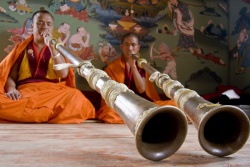The Mind-Seal: Transmission and the Legacy of Chan
From Shakyamuni Buddha on, throughout the history of Buddhism in India, great emphasis was placed on the transmission between a Master and a disciple. It is the same in Tibetan Buddhism and for all Buddhists.
Master Sheng Yen
From Buddha to Mahakashyapa
When Mahakayashapa smiled as the Buddha silently held up a single flower at Vulture Peak, the Buddha turned to Mahakashyapa and smiled in return.
In Chan legend it is said that the Buddha then said: "I have the true Dharma eye, the marvelous mind of nirvana, the true form of the formless, and the subtle Dharma gate, independent of words and transmitted beyond doctrine. This I have transmitted to Mahakashyapa."
In so doing, the Buddha entrusted the teaching of the Dharma to Mahakashyapa.
In the Chan tradition, this story is often cited as the first instance of the Buddha transmitting the Dharma to a disciple.
What exactly was transmitted? As the Buddha said, there can be no answer either in the form of words or reference to the teachings. If one says that what is transmitted is enlightenment, then this makes no sense either, because enlightenment must be realized by the individual and cannot be transmitted by a master, not even a buddha.
When Mahakashyapa responded to the Buddha's gesture with a smile (and perhaps a nod), whatever transmission there was took place in that instant, and the Buddha's response was simply to acknowledge that. Understood this way, then transmission becomes a mind-to-mind recognition between a master and disciple that the disciple has realized the "true Dharma eye." In Chan, this exchange between a master and a disciple is sometimes called the "mind-seal," or yinke (Jap. inka).
The term "mind-seal" is derived from the Chinese tradition of an emperor or high authority using a red-inked stamp, or seal, to authenticate important documents. Thus, by analogy, yinke (Jap. inka) is a master's using the mind-seal to authenticate the realization of enlightenment in a disciple.
By concluding, "This I have entrusted to Mahakashyapa," the Buddha established Dharma lineage in the form of "trust;" the Buddha was trusting Mahakashyapa to properly transmit (teach) the Dharma.
There is thus a private as well as public aspect to Dharma transmission. On the one hand, there is the private mind-to-mind recognition between master and disciple, and then there is the designation of the disciple a Dharma heir. Even though the story of the Buddha and the flower may be apocryphal, it does symbolize the meaning of transmission as understood in the Chan tradition.
In Dharma transmission no "thing" is transmitted; certainly not the Dharma, which the receiver of transmission has already realized through their own efforts. What is transmitted is the recognition by the master that the disciple not only has realized awakening but is ready to become an heir in the Dharma lineage. Transmission is not just a matter of granting the disciple permission to teach Chan, since the disciple may already be a teacher with students of their own. Rather, it grants the disciple the authority to teach Chan as a representative of the master, as well as of the lineage.
The conditions for transmission
Under what circumstances would a master give transmission to a disciple? While there are several conditions that are important, the following are paramount:
The master has sanctioned the disciple's realization of the emptiness of self and therefore holds correct views.
The disciple is on the bodhisattva path of right action.
The disciple is committed to fulfilling the Four Great Vows.
The master deems the disciple ready to teach Chan as an heir in the lineage.
Realization
To receive transmission the disciple needs to have experienced no-self, or "buddha-nature." That is to say, the disciple has directly perceived that the true nature of phenomena is that of emptiness. As the Heart Sutra says, "Form is precisely emptiness, and emptiness is precisely form." This emptiness is not the nihilistic emptiness of "void" but the emptiness of things lacking enduring self-identity and separateness. This emptiness characterizes all forms, including the form of "self."
This realization of emptiness is possible only when the mind is without any trace of attachment. (For more on "buddha-nature," see Lesson 7.) Realization also means that the disciple possesses the correct view, which includes comprehending and accepting the three seals or marks of existence (suffering, impermanence, and no-self), and thoroughly grasping the meaning of conditioned arising (dependent origination).
It should be emphasized that a master may confirm a student's enlightenment without also granting permission to teach or without giving transmission. Much has to do with the causes and conditions between master and disciple. After receiving confirmation, some disciples continue to practice rather than teach and, in some cases, enter solitary retreat. A master may grant permission to teach to a student who has yet to attain realization, but this would not include Dharma transmission. In other words, a sine qua non of transmission should be that the student has realized at least a rudimentary level of genuine enlightenment.
Right Action
The disciple should be following the path of Right Action. Fundamentally this means that the disciple upholds the precepts, practices the Six Paramitas, and otherwise follows the Mahayana bodhisattva path. (See Lesson 6, The Bodhisattva Path.)
Four Great Vows
The disciple's commitment to the Path is unwavering and guided by the Four Great Vows:
I vow to deliver innumerable sentient beings.
I vow to eliminate all vexations.
I vow to master limitless approaches to Dharma.
I vow to attain supreme buddhahood.
By practicing in accordance with the Four Great Vows, one is naturally emulating the Buddha's wisdom and compassion.
Readiness to teach
A master's confirmation of a disciple's realization is not in itself transmission. In order for that to happen, the master should also be confident that the disciple is ready to teach Dharma as a representative of the lineage, in other words, to become a Dharma "heir." The master should also feel confident that the disciple has the requisite character and "skillful means" to teach the concepts of Buddhism and the methods of Chan to others. If the disciple is already teaching and in fact, has the means and resources to support group practice, this would enter the master's decision on the disciple's readiness to teach. In some cases the master may grant limited transmission in which the disciple may teach but not yet give sanction and transmission to others.
Transmission is not necessarily a clear-cut process; much depends on the circumstances between the master and the disciple, as well as on the master's and the disciple's level of attainment. When masters lack the experience and the maturity to truly recognize a worthy heir —or worse, be less than worthy themselves—the authenticity of a lineage based on shallow or false transmissions will be damaged. In the past as well as in the present, transmissions have not always been worthy of the name. There is a Chan saying that sometimes the mind-seal is made of gold; sometimes it is made of tofu (bean curd).
Despite being open to questions of authenticity, Dharma transmission has been the method through which the lineages of Chan have perpetuated since Bodhidharma. The continued vitality of the lineage attests to the fact that there have always been a small number of outstanding and worthy Chan masters who transmitted to worthy disciples.
As one can readily see, transmitting to a Dharma heir may be the single most important action that a Chan master may undertake as a teacher. For, while the master and the disciple are the proximate actors in this drama, the true benefactors are the lineage and its followers, for Dharma transmission is the means by which the lamp of Chan is passed from one Dharma generation to the next, vital and intact.




